2025 Alumni
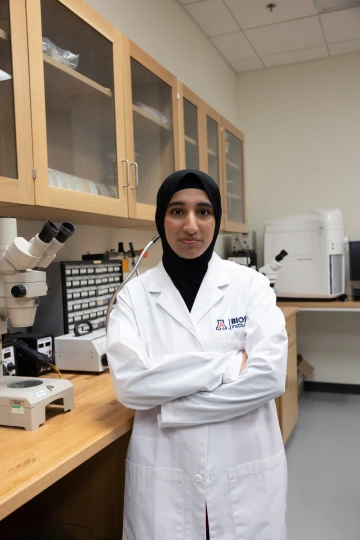
High School: BASIS Oro Vallley
City: Oro Valley
Faculty Mentor: Dr. Michael Brown
Research Project: Unseen Forces Behind G-Protein Coupled Recept
G-protein coupled receptors (GPCRs) are membrane proteins central to cell signaling and major drug targets. Rhodopsin, a light-sensitive GPCR in the eye, models GPCR function. Many GPCR studies overlook natural conditions by using artificial environments [1]. Understanding how environmental factors like temperature and hydration affect protein behavior reveals how GPCRs function and can guide treatment development [2]. Using UV-Visible spectroscopy, we investigated how temperature and hydration influence rhodopsin activation and the balance between intermediate Meta I and Meta II states. Results show that higher temperatures and increased hydration favor the active Meta II state, supporting rhodopsin activation as endothermic and entropy-driven. These findings emphasize the role of the environment in GPCR behavior, providing better understanding of protein behavior and offering new insights for drug design.
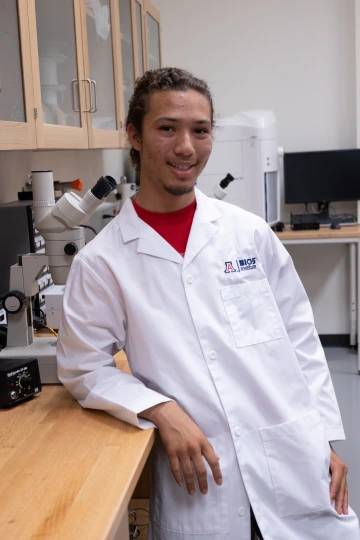
High School: BASIS Oro Vallley
City: Tucson
Faculty Mentor: Dr. Alexander Bucksch
Research Project: Capturing the Root Interactome
Quantifying root shape underground is a nearly impossible task because soil is opaque. However, by digging roots in a consistent manner and compiling images into a 3D model, the quantification process can be automated. The relative ease of this process allows for large-scale phenotyping, giving us the root traits necessary to select for desired traits in breeding programs. I am using bean roots to quantify root-to-root interactions in mature roots. By growing the beans on layers of mesh within the dirt, we mitigate the destruction caused by extraction, allowing us to better analyze architectural interactions. My job has been to measure sample roots and compare the measurements to the model results to assure the reliability of the system, allowing for its later implementation in agriculture.
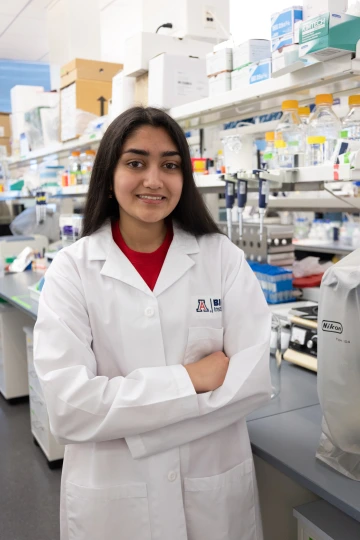
High School: Paradis Valley High School
City: Phoenix
Faculty Mentor: Dr. Mrinalini Kala and Co-PI Dr. Taben Hale
Research Project: Flow Cytometry Assay for Investigating Cardiac Fibroblast Activation
Cardiac fibroblasts (CFs) are cells that produce collagen in the heart. Angiotensin II (AngII) binds the Angiotensin Type 1 Receptor (AT1R), leading to CF activation and collagen production. The AT1R gene was selectively knocked down in mouse CFs. Left ventricles were collected, digested and prepared for flow cytometry. Flow cytometry was used to determine whether knocking down AT1R changed the proportion of CFs in male versus female mice. Our findings support that there is a higher proportion of CFs in female mice compared to males, but deleting the AT1R receptor did not appear to impact cell proportion.This research aims to open avenues in developing targeted therapies for cardiac fibrosis.
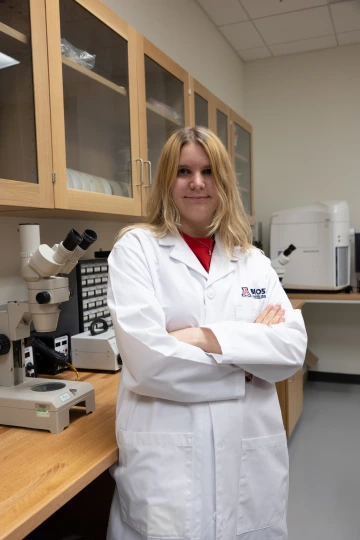
High School: Sahuaro High School
City: Tucson
Faculty Mentor: Dr. Haining Zhu
Research Project: Construction of a plasmid Vector Tool for Studying STING Protein Responses in Mammalian Cell Culture
The STING1 gene encodes the STING protein (U.S. National Library of Medicine, 2014), which when produced helps to regulate the immune system’s response to viral and bacterial infections (Wang et al., 2019). However, STING overproduction can lead to the growth and spread of tumors (Zhang et al., 2019). Our project focused on creating a plasmid containing the human STING1 gene. We can amplify these plasmids in bacterial cells, and then insert them into mammalian cells to express the STING protein. By confirming that this process works, this basic research will help scientists in the future study how STING levels can affect cell behavior and other connected proteins, broadening our knowledge on circumstances that could be used to facilitate long-term drug therapy.
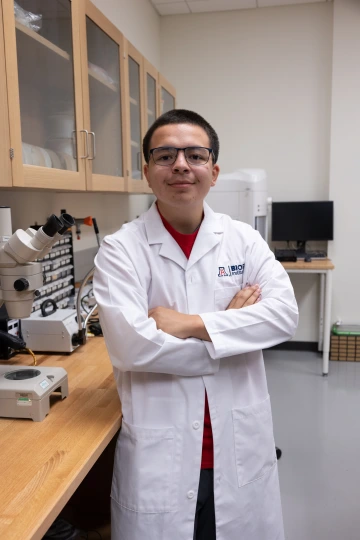
High School: Empire High School
City: Vail
Faculty Mentor: Dr. Thomas Gianetti
Research Project: Investigation of Triscation, a Water-Soluble Organic Molecule of Redox Flow Battery Applications
As the world shifts to renewable energy, durable and clean energy storage is crucial for fulfilling energy goals. Organic redox flow batteries are a promising solution due to ease of scalability, exclusion of expensive and environmentally damaging metals, and long lifespan. Battery function depends on two molecules donating and accepting electrons. We tested 5 organic molecules by utilizing a three electrode setup with a potentiostat (instrument that measures electric current) to gather information. Triscation stands as a potential molecule in these batteries as when dissolved in acetonitrile, batteries were observed to be stable and good operating voltage. Observations of triscation in water provide proof of concept yet further research is needed to determine compatibility with water.
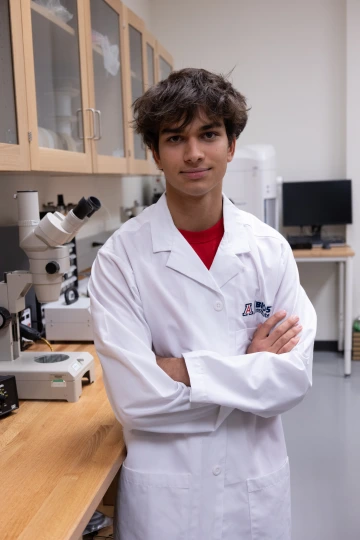
High School: The Gregory School
City: Tucson
Faculty Mentor: Dr. Nikolay Golubev
Research Project: Using Simulations to Model Atomic Transitions in Methyl Iodide
When a molecule’s bonds are stretched or compressed, potential energy is stored. This energy vs. displacement can be simply modeled by a parabola. Although exact nuclear positions are unknown, we can predict the most likely configurations using wave functions. These are solvable by Schrödinger’s Equation. By comparing wave functions between two forms of a molecule, such as neutral and ionized, we can find probable transitions through their overlap integrals [1]. I created an interactive Python script to visualize these overlaps as FCF-Spectrums. I also modeled a real-world example; Methyl iodide transitioning from its neutral to cationic form. Using the software, Molcas and ezFCF, I generated the FCF-spectrum that identified the most probable energy transitions. This work contributes to understanding particle behavior at the atomic scale.

High School: Arizona College Preparatory High School
City: Gilbert
Faculty Mentor: Dr. Haiquan Li
Research Project: Weed Detection with Deep Learning
One in two organic spinach cultures fail due to weed contamination, which effectively reduces yield, increases labor costs, and in conventional cultures, leads to high herbicide usage (De Cauwer et al., 2021). An object detection model (DETR), a form of deep learning model, that can accurately distinguish between crops and unwanted weeds, will enable agricultural sustainability. Our study focused on developing a DETR-based object detection trained on box-annotated image dataset of spinach and weeds under various field conditions and growth stages. I optimized hyperparameters such as learning rates, batch size, and gradient accumulation to improve detection precision. This model will serve as the foundation for all vision-based targeted weed solutions, such as automated spot spraying or laser weeding.

High School: Hamilton High School
City: Gilbert
Faculty Mentor: Dr. Bonnie LaFleur
Research Project: Evaluating Cognitive Function in Healthy Aging Adults
Longer lifespans make it important to understand typical cognitive aging. Tools like the Montreal Cognitive Assessment (MoCA), which detects Mild Cognitive Impairment (MCI), may overlook subtle, age-related changes [2]. As part of the Precision Aging Study, my project evaluated two cognitive tests, Keep Track and Paired Associates Learning (PAL), to assess normal cognitive decline due to aging [1]. We examined associations between test scores and demographic factors: age, BMI, sex, and hypertension. Using R, two regression models were made for visual comparisons. The relationship between the Paired Associates Test and the Keep Track and PAL tasks differs by MoCA group, with stronger associations (steeper slopes) seen in those with MCI. Linear regression shows that Keep Track and PAL scores decrease with higher age and BMI.
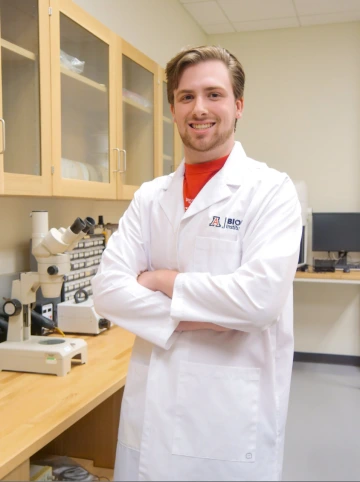
High School: Cienega High School
City: Vail
Faculty Mentor: Dr. Maya Kaelberer
Research Project: A Brain to Gut Circuit
Emotions shape how we sense food in the gut (Kaelberer, 2018), but how the brain communicates these signals to sensory neuropod cells in the gut is still unknown (Kaelberer, 2020). Research focused on the validation of the methods: Fluorescent In Situ Hybridization (FISH) and Immunohistochemistry (IHC) for the detection of pre/post synapses and neural-specific RNA. For both methods an array of antibodies were evaluated for their effectiveness in identifying synaptic markers and RNA transcripts. With FISH, we were able to successfully label neuropod cells of both the colon and small intestine, validating this method. This paves the way for subsequent research to determine the number of neuropod cells capable of receiving feedback from the brain, turning feelings into food.
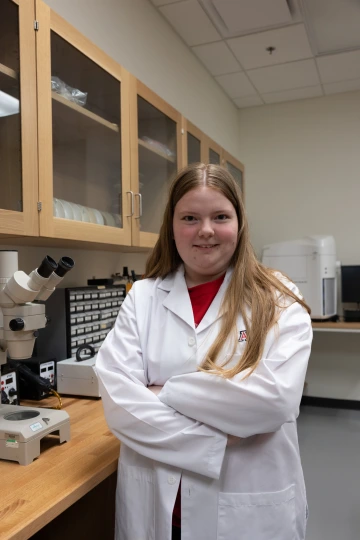
High School: BASIS Tucson North
City: Tucson
Faculty Mentor: Dr. Andrew Capaldi
Research Project: Tracking Nitrogen Transport and Synthesis Related to TORC1 Across Conditions
TORC1, Target of Rapamycin kinase Complex I, controls cell growth by activating downstream proteins[1,2]. Under nutrient repletion, TORC1 activates proteins encouraging cell growth, but during starvation, TORC1 drives cell harvesting and nutrient transport[1,2]. How does TORC1 behave under intermediate nutrient conditions? I tagged various nitrogen/amino acid transporters downstream of TORC1 with green fluorescent protein and visualized them using microscopy during the transition from a high-quality nitrogen source to a poor-quality nitrogen source, a source without nitrogen, a source without glucose, or to a rapamycin (TORC1 inhibitor) treatment. I found that Put4, a proline transporter, increased in abundance in proline treatment and complete nitrogen starvation, but not in rapamycin treatment, suggesting that nitrogen signals are communicated to Put4 independently of TORC1.
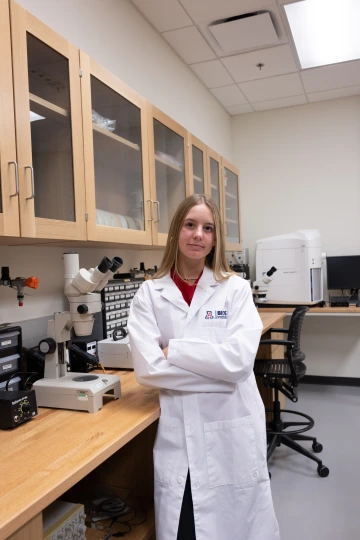
High School: Canyon del Oro High School
City: Oro Valley
Faculty Mentor: Dr. Swarna Ganesh
Research Project: Investigating Biomaterials for Degradable Drug Delivery
We are focusing on optimizing biomaterials for biodegradable tissue scaffolds for cancer drug delivery. A scaffold is made out of biomaterials like PEGDA; scaffolds hold the drugs we are trying to deliver to the tumor,degrade, then release drugs onto the tumor. We make multiple solutions of different biomaterials and then 3D print the scaffolds and cure them with UV light. To test the degradability, we looked at 2 parameters: temperature and pH. To determine if they were degrading over time, I studied the increase in pigment release using a nanodrop, showing scaffold degradation and constant release of the pigment. Optimizing the biodegradability of scaffolds is important because if they degrade too early or too late, the drugs inside will not have the intended effects.
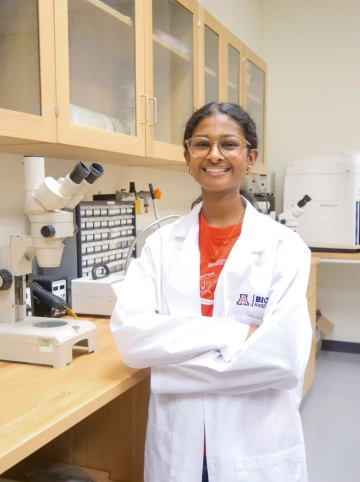
High School: BASIS Phoenix
City: Phoenix
Faculty Mentor: Dr. Haijiang Cai
Research Project: Deciphering Insatiable Hunger: A Neural Code Perspective on Prader-Willi Syndrome
Prader-Willi Syndrome (PWS) is a genetic disorder marked by insatiable hunger [1]. When protein kinase C-delta (PKC-δ) neurons in the central amygdala are activated, they typically subdue eating behavior. These neurons respond to cholecystokinin (CCK), a key hormone released by the gut [2]. This project investigates whether CCK activates these neurons and suppresses eating in a PWS mouse model through immunofluorescence and microscopy. Using this neuronal activity mapping, I found that PKC-δ neurons are less responsive to CCK, despite CCK's effectiveness in reducing food intake in these mice. These findings provide insight into the neurobiological mechanisms driving altered eating behavior in PWS, suggesting a complex relationship between CCK signaling and eating regulation in this disorder.
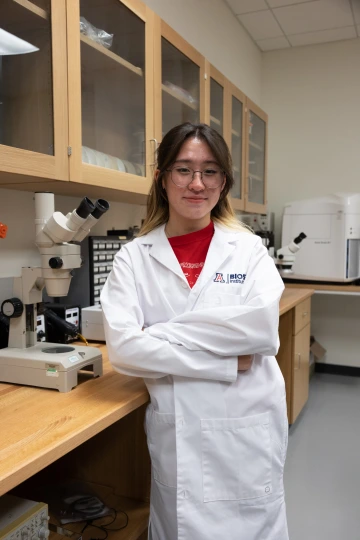
High School: University High School
City: Tucson
Faculty Mentor: Dr. Jason Karnes
Research Project: Investigating the effect of PSG1 Gene Copy Number Variations on Warfarin Dosing
Warfarin is a commonly used blood-thinner that works to prevent the formation of blood clots and, subsequently, heart disease. However, the dose requirement varies for every person and receiving the incorrect dose could lead to excessive bleeding. I focused on finding a correlation between the gene PSG1’s copy number variations—or the number of times a gene is present in a chromosome—and Warfarin dosage. I used a DNA amplification method to isolate one section of PSG1 and determine the copy number of each DNA sample. While I didn’t find a statistically significant relationship between PSG1 copy number variations and Warfarin dosage, my project contributes to the currently limited studies on copy number variations and underlines the importance of genetics in pharmaceutical research.
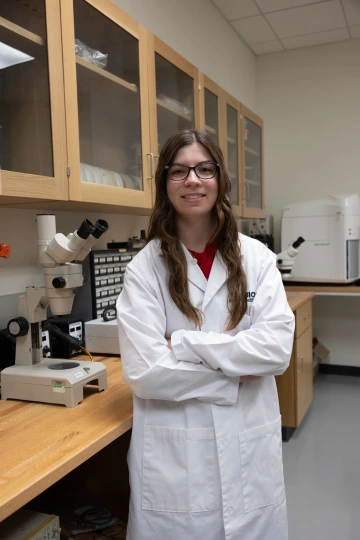
High School: Ironwood Ridge High School
City: Tucson
Faculty Mentor: Paulo Pires
Research Project: Reactivity of Astrocytes in Diseased (Alzheimer's) and Non-Diseased States
Astrocytes are support cells in the brain that contribute to the progression of Alzheimer’s disease (AD) [1]. I analyzed the structure of the cells in the brains of mice with AD and without AD, and we looked at their reactivity and determined the type of reactivity astrocytes have in diseased states compared to non-diseased states. Then, I used immunohistochemistry, a technique that uses antibodies to “tag” proteins with fluorescent markers for imaging [6]. We found that the astrocytes in mouse MA had higher surface area sums and percent area coverage than in mouse M1; thus indicating mouse MA had AD while mouse M1 did not. With a better understanding of how to control astrocytic reactivity, a possible therapy for Alzheimer’s patients could be developed.

High School: Perry High School
City: Gilbert
Faculty Mentor: Dr. Travis Sawyer
Research Project: Combining Haralick Features and Machine Learning for Classification of Pancreatic Cancer
Pancreatic cancer (PC) can be difficult to remove during surgery.1 The goal of this project is to improve tumor margin estimation with the hope to offer surgeons a more accurate way to remove PC while preserving healthy tissue. Samples of PC were imaged, and a Python code was developed to select three regions of interest (ROI) for each sample: Tumor, Margin, and Normal. Haralick features, mathematical formulas used to describe textures2, were calculated from these ROIs, and the statistically significant features were used to train a machine learning model (MLM). Our MLM had a 0.725 accuracy when classifying tumor versus normal ROIs. Next steps include optimizing the MLM to better estimate PC margins with the hope to improve surgical outcomes for patients.
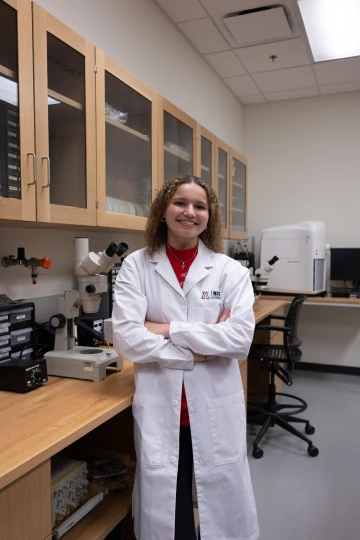
High School: Salpointe Catholic High School
City: Sahuarita
Faculty Mentor: Dr. Minkyu Kim
Research Project: Development of Red Blood Cell-Inspired Microparticles Using Mechanical Protein Copolymers
The Red Blood Cell Bio-Inspired Lab is working to create artificial Red Blood Cells to address blood shortages, reduce dependence on donors, and support rural medicine. Various proteins capable of binding one another were produced. These proteins varied in stiffness, and their productions were optimized by changing production conditions such as incubation temperature and expression rates. It was found that the stiff proteins (ST-Ni6C-ST and SC-Ni6C-SC) were expressed best at 37°C, and the flexible protein (SC-C7-SC) was expressed best at 30°C. We optimized the production of binding proteins with varying stiffness, and tested different ST:SC ratios to determine whether they formed long chains suitable for the cytoskeleton structure of RBCs that can be used for targeted drug cell delivery and blood transfusions.
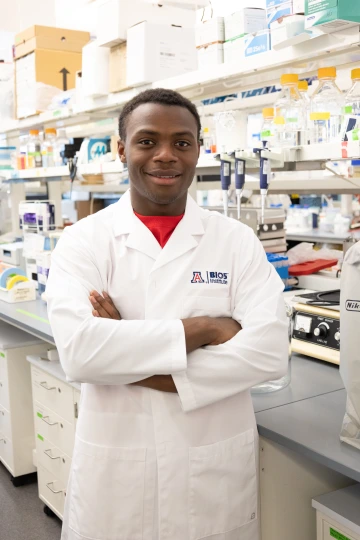
High School: Brophy College Preparatory
City: Phoenix
Faculty Mentor: Dr. Melissa Herbst-Kralovetz
Research Project: Genome Sequence of Endometrial Schaalia turicensis Strain R31 from a Patient with Adenomyosis
Schaalia turicensis, a Gram-positive bacterium, is commonly found on mucosal surfaces but has been linked to infection. Its presence in the uterine microbiome is emerging, yet its genomic characteristics remain poorly understood. We sequenced and analyzed the draft genome of S.turicensis strain R31, isolated from a patient with adenomyosis. Sequencing produced contigs totaling ~1.97 Mb with a GC content of 56.83%. Annotation revealed coding sequences, including metabolic, stress response, and antibiotic resistance genes. Phylogenomic analysis confirmed placement within the Schaalia genus. Functional gene content, membrane remodeling, and resistance suggests this strain adapted to persist in uterine tissue. Findings support the relevance of S.turicensis in gynecologic health and provide a foundation for future studies on its potential role in endometrial cancer.
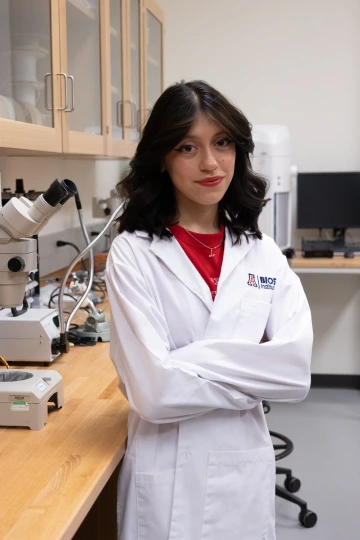
High School: Arizona Virtual Academy
City: Tucson
Faculty Mentor: Dr. Vignesh Subbian
Research Project: Behavior and Safety of Inexperienced Drivers
Young drivers aged 16–24 account for 17.18% of Arizona’s fatal crashes (2019–2023), contributing to over $40 billion in annual crash-related costs nationwide. Of these, 33.85% involve preventable single-vehicle incidents—often tied to poor hazard recognition and decision-making within a critical 2–3 second window. This study analyzes NHTSA FARS crash data and proposes a simulator-based evaluation of smart safety technologies among newly licensed drivers. Inspired by Automatic Emergency Braking’s 43% crash reduction [1], the project introduces Driver Mentor Mode (DMM), a conceptual real-time feedback system that delivers adaptive coaching to reduce risk before errors occur. Findings aim to inform policy recommendations for enhancing Graduated Driver Licensing (GDL) laws, modernizing driver education, and integrating proactive safety tools into federal Vision Zero initiatives.
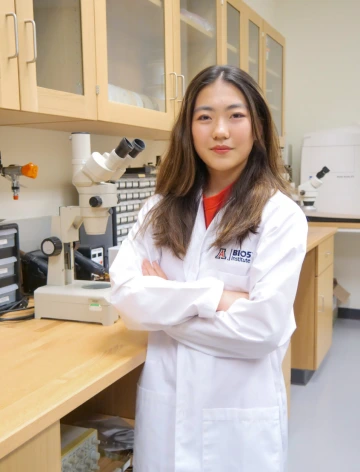
High School: University High School
City: Tucson
Faculty Mentor: Dr. Hongmin Li
Research Project: Inhibiting PurB as a Drug Target for Mycobacterium Tuberculosis
Purine biosynthesis is a vital pathway for creating energy and purines (components of DNA/RNA).Adenylosuccinate lyase (PurB) is an essential enzyme inside the purine pathway, correlated to the bacterium Mycobacterium tuberculosis (Mtb) that causes tuberculosis, a highly prevalent and deadly microbial disease8. We investigated three BT analogs/compounds to see if they inhibit PurB and block its activity. Using bioluminescent experiments (PPDK-luciferase coupling systems) to quantify PurB enzymatic activity, inhibitory activity was confirmed. Thermal shift experiments demonstrated stable binding of analogs to PurB, and the analogs displayed antibacterial activity against Mtb, with minimal toxicity toward human cells. These results provide a framework for the development of selective PurB inhibitors as potential anti-tubercular agents which can be further studied to create effective antimycobacterial drugs.
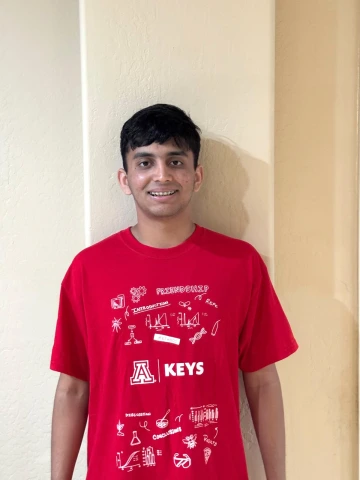
High School: Arizona College Preparatory High School
City: Chandler
Faculty Mentor: Dr. Nan-Kuei Chen
Research Project: Investigation of Functional MRI Methods and Applications to Studies of the Glymphatic System
The glymphatic system clears brain waste using blood and cerebrospinal fluid (CSF), and disruptions in CSF flow have been associated with neurodegenerative diseases such as Alzheimer’s disease1. My research examines the relationship between CSF flow and brain activation using MRI and functional MRI. Using MATLAB, I processed MRI and fMRI data to generate CSF variation maps (standard deviation) and brain activation maps (cross-correlation) during a finger tapping task. Then we used spatial correlation to test if regions with more CSF have greater brain activation. We found a weak positive correlation (r = 0.0698), suggesting a very minimal overlap between CSF presence and brain activation. These findings provide a foundation for studying CSF/brain activity relationships and developing non-invasive approaches to detect and regulate neurodegenerative diseases.

High School: Catalina Foothills High School
City: Tucson
Faculty Mentor: Dr. Chris Frost
Research Project: Green Leaf Volatiles Prime Plants Against Herbivory
Green leaf volatiles (GLVs) are chemicals that plants produce in response to damage or herbivory. GLVs may therefore act as signals of impending damage that prime unwounded plants, allowing for preemptive defense activation (Ameye et al., 2018). First, we show that herbivore-damaged corn releases a diverse set of volatile compounds, including GLVs, that are not emitted from unwounded plants. We then investigate whether pre-exposure to the GLV z-3-hexenol (z3HOL) affects plant responses to future herbivory. Remarkably, plants exposed to z3HOL enhance jasmonic acid (JA) production, a hormone that regulates responses to herbivory. However, pre-exposure to z3HOL does not directly induce JA, indicating the plants are primed for future herbivory. These findings deepen our understanding of the complex chemical language of plants and their environmental resilience.
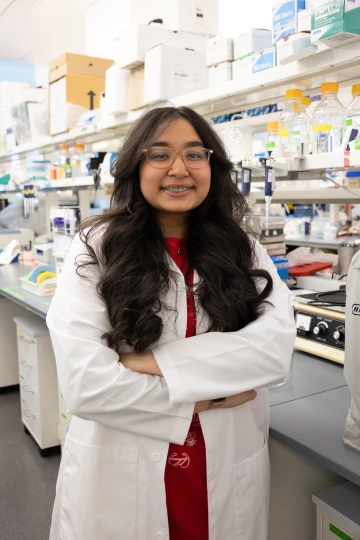
High School: Desert Mountain High School
City: Scottsdale
Faculty Mentor: Dr. Isabelle Schrauwen
Research Project: Finding Casual Variants of Inner Ear and Auditory Nerve Malformations
The goal of this project is to discover causal variants of extreme and rare inner ear and nerve malformations in children. Before starting analysis, reported family relations were verified. Then, we analyzed their genetic data for mutations, and used CADD scores to determine whether the variant was dangerous; the higher the score the more pathogenic it is. If dangerous, we checked gEAR (gene expression analysis resource) to determine if there was high expression in the ear, indicating danger to the ear. After, sequencing was performed to validate and verify results. We have identified nine possible variants and we expect at least two will be pathogenic variants. Affected children can use the information to understand the unknowns of their condition and possibly move forward with treatments.
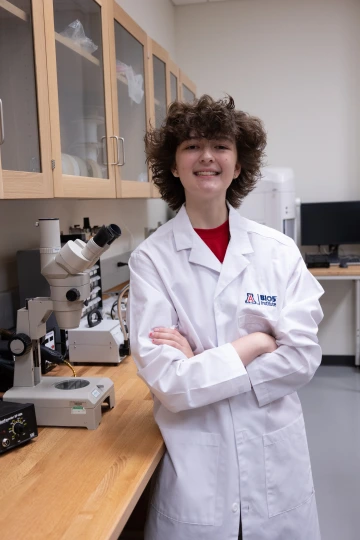
High School: Academy of Tucson
City: Tucson
Faculty Mentor: Dr. Martha (Molly) Hunter
Research Project: Nutrient-microbe Tradeoffs: How Environmentally Acquired Symbionts Influence Insect Growth
Caballeronia is a nutritional bacteria that is vital for the development of Leptoglossus zonatus(leaf-footed bug). Without Caballeronia, leaf-footed bugs cannot mature into adulthood to reproduce. I’ve been researching how different Caballeronia strains affect development & reproductive benefit. To determine the answer I have been raising six sets of leaf-footed bugs
with different strains of Caballeronia bacteria. After raising the bugs to adulthood, we collected their weights and the time it took to reach adulthood. Studying the costs and benefits of host-microbe dynamics is important because these interactions happen to all animals, including humans. Looking at connections on smaller scales gives a better understanding of the whole picture.
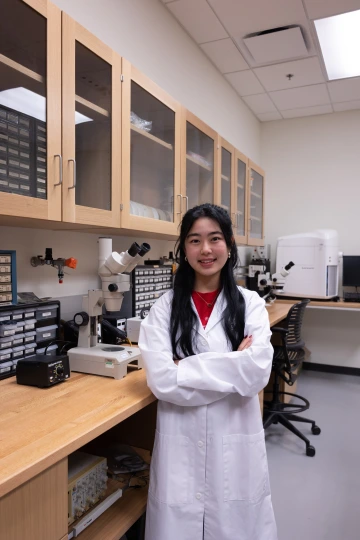
High School: University High School
City: Tucson
Faculty Mentor: Dr. Kellen Chen
Research Project: CD64+CD14+ as a Marker of Healing in Diabetic Wound Microenvironments
25% of the 830 million people with diabetes worldwide experience impaired wound healing because insulin resistance and high blood glucose levels weaken immune responses and tissue repair [1, 2]. Investigating immune-related proteins CD14 and CD64- and inflammation pathway related EGR1- we hypothesized increased expression and colocalization of these proteins associated with improved wound healing through effective early immune responses. A cryostat sectioned frozen tissue samples from non-diabetic, diabetic healing, and diabetic non-healing wounds. Sections underwent immunocytochemistry with specific primary/secondary binding antibodies. Confocal microscopy and an unique MATLAB pipeline imaged and quantified the proteins. Diabetic healers showed higher colocalization than non-healers, and non-diabetic had the highest. Therefore, their presence supports effective immune responses and are potential biomarkers for enhancing wound healing in diabetic patients.
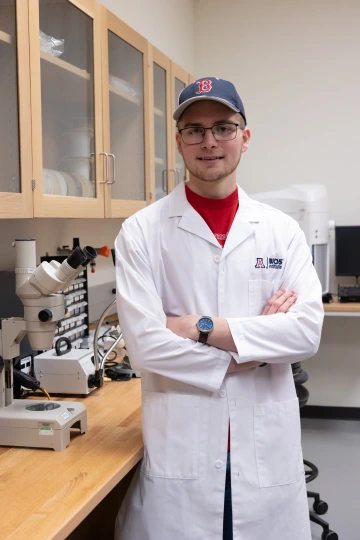
High School: Sahuarita High School
City: Sahuarita
Faculty Mentor: Dr. Haining Zhu
Research Project: Creating Plasmid Tools with Tau Gene for Studying Tau Protein Responses in Mammalian Cell Culture
Over 7 million Americans live with Alzheimer’s and by 2050, the number is expected to rise to almost 13 million [1]. Alzheimer’s is one of many neurodegenerative diseases caused by abnormal aggregation of a protein called Tau [2]. For my project, I developed a plasmid tool–a small DNA strand used to carry genes into cells–containing a Tau gene that can be used by researchers to express and better understand Tau protein. The plasmids were created by extracting Tau from a pre-existing plasmid, creating copies, and inserting into the target plasmid. The final product can be used in a variety of experiments testing how mammalian cells containing Tau react under normal baseline and stressful conditions to further our understanding of Tau.
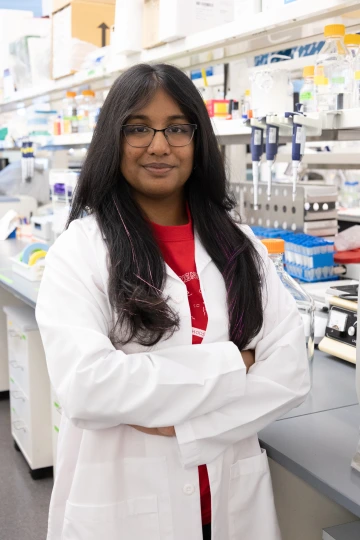
High School: BASIS Phoenix
City: Phoenix
Faculty Mentor: Dr. Shirin Doroudgar
Research Project: Investigating the Role of PAM in Regulating Cardiac Myocyte Hypertrophy and Secretory Pathway Gene Expression
Heart disease is the leading cause of death in America.1 To better understand how it affects the heart, we studied a protein called PAM, which helps heart cells stay healthy and control their size. We removed the expression of PAM in half of our neonatal rat heart cells to compare the results to the half where it was present. We found that when PAM is missing, the cells produce more of the genes linked to stress and trouble with handling proteins. Additionally, the cell size shows with an absence of PAM and added phenylephrine, the cell grows bigger, leading to cell death. This shows PAM is important in the vitality of cells when there is pressure applied.

High School: Mountain Ridge High School
City: Glendale
Faculty Mentor: Dr. Tyson Swetnam
Research Project: Does Artificial Intelligence Make Research More Efficient
Large Language Models (LLMs) show potential in academic research, but are limited due to poor connectivity with specialized tools – frameworks that combine Model Context Protocol (MCP) with Artificial Intelligence LLMs. Our study compared research workflows before and after MCP integration. The "Before MCPs" condition included scientists conducting experiments, manually
entering data, organizing data for external applications’ analysis, and collecting the data for presentation. The "After MCPs" condition was streamlined; scientists used applications moving directly from data collection to analysis and then presentation. MCP-enhanced workflows were infinitely more efficient – testing suggests these AI integrated tools could improve research productivity by accessing diverse databases and applications. These findings are crucial for full potential interaction with AI and may revolutionize research by creating powerfully interconnected work environments.

High School: Sonoran Science Academy
City: Tucson
Faculty Mentor: Dr. Philipp Gutruf
Research Project: Characterization of Humidity's Effects on CO2 Readings on Various Environments
The human body reacts to stimuli like exercise and stress by releasing gases such as CO2 and volatile organic compounds (VOCs). Developing wearable devices that accurately detect these emissions can help identify health issues early. (Clausen et al., 2025) This research focuses on stabilizing humidity fluctuations that disrupt CO2 sensor performance based on thermal conductivity. Testing different membranes (sensor boxes) revealed that the double Alkali-Scientific and Porex layered membranes provide optimal protection for sensors while ensuring accurate results. Improved selectivity and accuracy in wearable sensors could facilitate real-time monitoring of metabolic processes, promoting proactive health management and healthier lifestyles, ultimately lowering healthcare costs. Future work will enhance these devices for everyday health assessments.
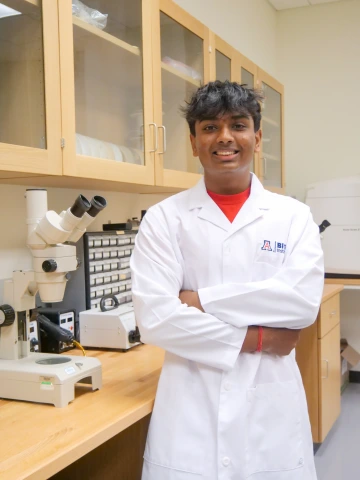
High School: Arizona College Preparatory High School
City: Chandler
Faculty Mentor: Dr. Ross Buchan
Research Project: Assessing the Role of G3BP1 and G3BP2 Proteins in Proper Regulation of Cell Cycle Checkpoint Decisions
G3BP1 and G3BP2 assemble stress granules during cellular stress and also contribute to proper mitotic regulation. CRISPR-engineered U2OS cell lines lacking G3BP1, G3BP2, or both (double-null) were analyzed alongside wild-type controls. Cells were arrested at G2/M with nocodazole(a microtubule depolymerizer) or R0-3306 (a CDK1 inhibitor) and then released. Using flow cytometry, we found aneuploidy only in G3BP2-null cells after release, not in wild-type, G3BP1 null, or double-null cells. We quantified cell death by counting propidium iodide–positive nuclei on a CellCyte imaging system, showing increased PI-positive cells only in G3BP2-null cultures. Thus, G3BP2 is essential for chromosome stability and survival after mitotic arrest. By studying checkpoint regulation by RNA-binding proteins, our research advances precision oncology and cell-cycle biology, guiding therapeutic strategies and cancer research.
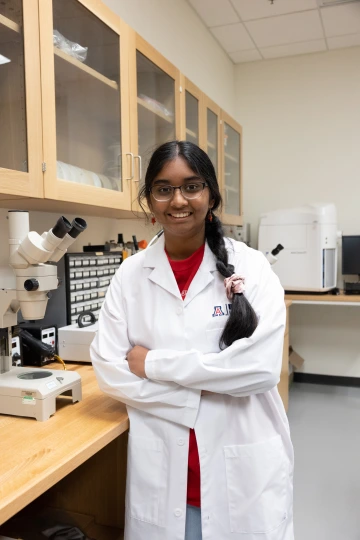
High School: University High School
City: Oro Valley
Faculty Mentor: Dr. Tarjani Thaker
Research Project: Investigating the Impact of ADCK4 Mutations on Coenzyme Q Biosynthesis in Human Podocytes
The ADCK4/CoQ8b gene is responsible for the biosynthesis of proteins that are vital in cellular respiration and ATP production, especially in high-energy demanding organs such as the kidney.2,3 As many patients with ADCK4 mutations develop nephrotic syndromes and eventually end-stage renal disease, understanding the role of these kinases is important.3 Two novel mutations were recently discovered in a patient who had severe kidney defects leading to end stage renal failure.1 We aim to study the effects these mutations have on CoQ10 synthesis in kidney cells. After conducting a CoQ10 assay, we observed a decrease in CoQ10 synthesized in ADCK4 knockout cells when compared to the wild type. This signifies that these mutations decrease CoQ10 levels and negatively affect ATP production.

High School: Arizona College Preparatory High School
City: Chandler
Faculty Mentor: Dr. Ryan Gutenkunst
Research Project: Extent of Artificial Genomes can be Relied on in Medicine and Research
With the widespread reliance of technology, medical records are at the forefront of ethical controversy. Being able to quickly access immunization records or genomic data at your fingertips are desirable information for personal use and hackers. I looked into how much artificial genomes can be relied on for medical and research purposes.This process of making artificial genomes is called generative adversarial network and is made from input data, a neural network, and a learning model[2]. After getting artificial genomic data we are able to find the genetic variation by comparing it to actual genomic data and finding the statistical difference of population demographic to recognize if artificial genomes can reliably map genomes[3]. The artificial genomes do not accurately predict the demographic population.
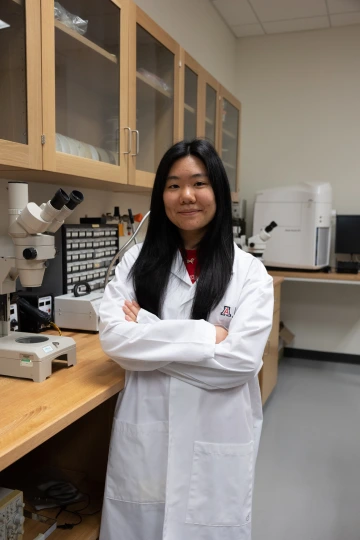
High School: BASIS Scottsdale
City: Fountain Hills
Faculty Mentor: Dr. Elizabeth Hutchinson
Research Project: Comparison of Beta-Amyloid Plaque Area and Count to MRI Metrics
Alzheimer’s disease (AD) is a neurodegenerative disease that affects memory and thinking. Diagnosis typically occurs after the disease has caused severe brain damage. My lab researches different MRI techniques to validate biomarkers like beta-amyloid plaques (protein accumulations that disrupt brain function) [3,5]. I compared microscopy images of beta-amyloid plaques in the
hippocampus with MRI metrics. From microscope images of 10 post-mortem temporal lobe samples from AD patients, I analyzed the area and number of plaques using an image analysis software. The data compared with previous MRI metric data using correlation analysis showed how accurate and reliable the metrics are. Correlation between MRI and microscopy validates AD biomarkers, aiding in early stage diagnosis of AD prior to brain damage.

High School: Hamilton High School
City: Chandler
Faculty Mentor: Dr. Joanna Masel
Research Project: Analyzing the Origin and Evolution of the Reverse Gyrase Protein
The reverse gyrase protein is found in organisms living in extremely high temperatures, maintaining the structure of genetic material [1]. My research determines the origin and evolution of reverse gyrase, and its presence in the last universal common ancestor (LUCA) of all existing life. We analyzed protein databases to find combinations of protein units characteristic to reverse gyrase and their frequency in other proteins. Common combinations often evolve earlier in evolutionary history [2]. A phylogenetic tree of proteins containing base combinations of protein units associated with reverse gyrase demonstrates that reverse gyrase first evolved through transfers of genetic information between unrelated organisms rather than generationally. The conclusion indicates the absence of reverse gyrase in LUCA, with implications in understanding characteristics and conditions of early life.
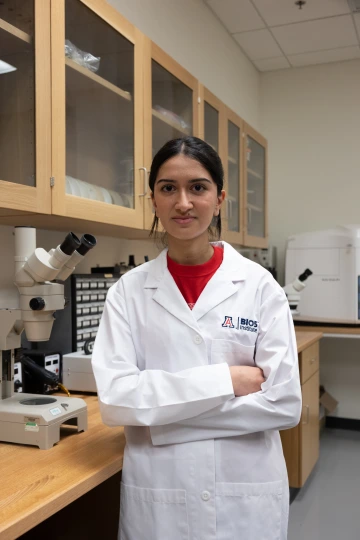
High School: BASIS Oro Valley
City: Tucson
Faculty Mentor: Dr. Paulo Pires
Research Project: Role of APOE4 and Cellular Cholesterol in Cerebrovascular Disease
Cerebrovascular disease (CVD) is characterized by impairments in blood vessel function & thus blood flow regulation. The E4 variant of the apolipoprotein E (ApoE) gene is a risk for CVD. Reduced contractile ability of blood vessels is a characteristic of CVD, a process dependent on voltage-gated calcium channels (CaV1.2). Data show that cerebral arteries’ contractile ability is diminished in a humanized ApoE4-knock-in mouse, due to reduced CaV1.2 channel function or expression. We hypothesize that CaV1.2 channel abundance will decrease with ApoE4, decreasing blood vessels’ contractile ability. We performed immunohistochemistry to identify CaV1.2 channels in smooth muscle cells and quantified them using ImageJ FIJI. Understanding the underlying mechanisms of CVD and ApoE4 will improve approaches to both CVD treatment and various neurodegenerative diseases.
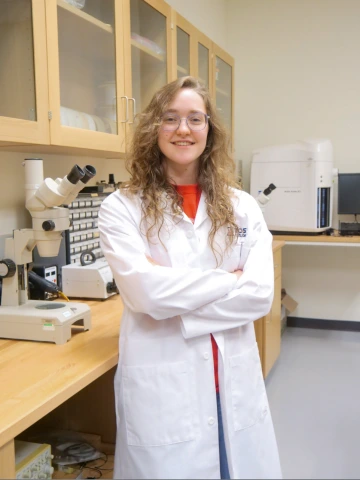
High School: The Gregory School
City: Tucson
Faculty Mentor: Dr. Alex McGhee
Research Project: Perfusable Brain-On-A-Chip with Granular Hydrogels
Physiologically relevant brain models are needed to better understand cancer. Organoids, the most common 3D brain model, are limited. There is no perfusion, which starves the tissue, and it doesn’t replicate shapes found in the body [7]. To address these problems, my project uses granular hydrogels, tiny particles made mostly of water, to add structure, distance, and perfusion
as the cells self-assemble [5]. PC12 cancer cells, which can transform to look like neurons, and granular hydrogels were loaded into a fluidic channel. Using a confocal microscope, the cells were imaged. Over a week, the structure transformed into a network of cells and granules. In further research, cancerous cells may be added to this model of healthy tissue in order to study its effects.
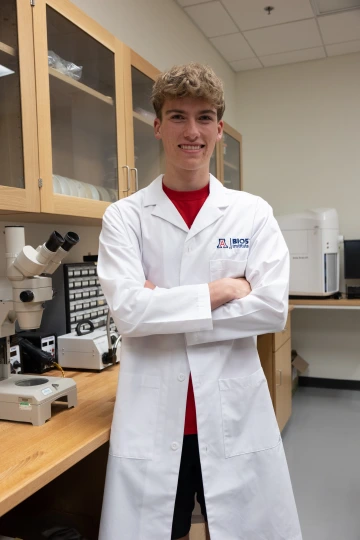
High School: Tanque Verede High School
City: Tucson
Faculty Mentor: Dr. Pascale Charest
Research Project: Investigating mTORC2 Activation of PKCδ and PKCζ to Drive Cell Migration Signaling Pathway
Directed cell migration is essential for development, tissue maintenance, and immune responses. Dysregulation contributes to cardiovascular disease and cancer metastasis. While many migration-related genes and proteins are known, the complete process remains unclear. The mechanistic Target of Rapamycin Complex 2 (mTORC2) regulates cell motility, survival, and metabolism, and is implicated in abnormal cancer cell migration, though its signaling mechanism is incompletely understood. This study examined mTORC2 activation in MCF10A cells using different chemoattractants. Western blot analysis assessed downstream AKT and PKC substrate activation. Each chemoattractant induced rapid mTORC2 activation, yet PKC phosphorylation was temporally dependent on the chemoattractant used. These findings demonstrate that chemoattractants activate signaling pathways used in cell migration through distinct mechanisms. Understanding these differences may inform targeted therapies to inhibit cancer metastasis.
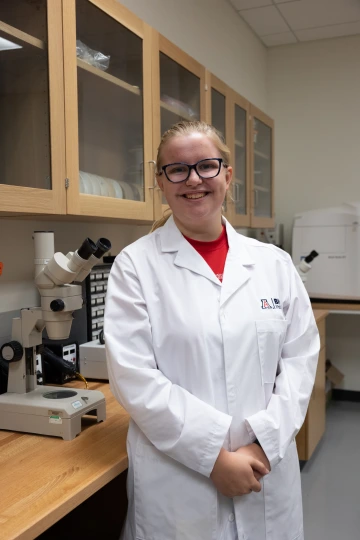
High School: Mica Mountain High School
City: Tucson
Faculty Mentor: Dr. Michael Taylor
Research Project: Investigating Cyanosubstituted Synthesis of Glycyl Radicals in Protein Interactions
Glycyl radicals (GRs) can be used to trap protein interactions, allowing them to be mapped. These radicals are crucial in creating metabolic pathways. GRs can be made via cyanosubstitution, where a tryptophan mimic (molecule that bonds similarly to tryptophan) is bonded to a glycyl group then broken off, leaving behind an electron. We synthesised tryptophan mimics with CN groups at two different bond sites (4 and 6) to see if the location of the group impacted production of GRs. We purified and isolated the mimics using chromatography and water precipitation. We then analyzed the molecules with NMR and found that 6-CN groups are harder to purify than 4-CN groups, meaning GRs are more likely to form in reactions with CN functional groups on the 4-bond.
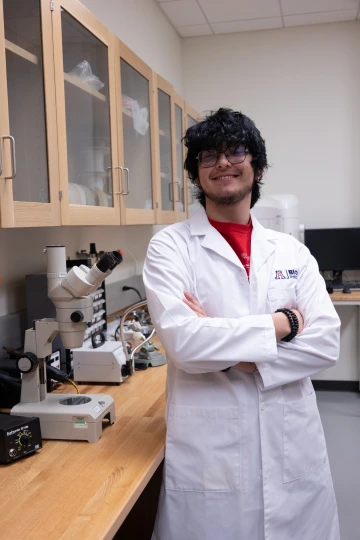
High School: Maryvale High School
City: Phoenix
Faculty Mentor: Dr. Michael Riehle
Research Project: Starving the Beast: Mosquito Midguts and the Malaria Parasite
The malaria parasite develops in the midgut of a mosquito using Vitamin B5, and the lab has proved that by inserting an extra PanK gene you could lower the amount of B5 in the mosquito midgut, killing the parasite (1). Our lab wants to know what effect this extra gene has on the fitness of the mosquito, and where the transgene is expressed. To test fitness, we measured the eggs laid by both the transgenic and non-transgenic population of mosquitoes, also identifying transgene expression through PCR and western blotting. Data suggested that the gene is only being expressed in the midgut of the transgenic mosquitoes—which is expected—and suggested egg production is not affected, showing potential as an ecologically friendly control for malaria.

High School: University High School
City: Tucson
Faculty Mentor: Laura Meredith
Research Project: Increasing Soil H2 Uptake through Biostimulation
Rising hydrogen gas levels from human activity have harmed the atmosphere, allowing greenhouse gases methane and ozone to persist longer [7]. However, soil microbes absorb about 80% of atmospheric hydrogen [5]. We investigated whether biostimulation (adding soils pre-exposed to hydrogen) would let soil consume more hydrogen, with microbes from one soil growing in the other. We tested soils from three locations, adding external soil from a hydrogen plant to each and exposing them to hydrogen for three weeks. We found adding soil pre-exposed to elevated hydrogen greatly increases hydrogen consumption, and soil pre-exposed to atmospheric hydrogen had little to no effect. This provides a greater understanding of hydrogen consuming microbes and could be a potential solution to mitigate excess hydrogen emissions.
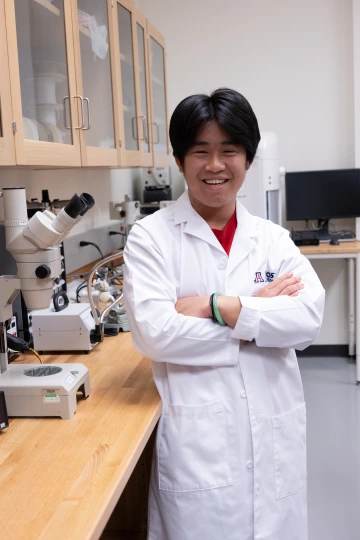
High School: BASIS Tucson North
City: Tucson
Faculty Mentor: Dr. Mohamed ElKabbash
Research Project: Using the Acousto-Optic Effect to Determine the Pressure of a Membrane
Measuring intraocular pressure (IOP) within the retina is heavily dependent on the IOP of the cornea4. Ophthalmologists correlate high retinal IOP to eye diseases such as macular (retinal) degeneration and require new methods of measurement5. My research investigated using the acousto-optic effect, when a material bends light due to an applied sound wave, in order to measure the pressure of/behind a membrane2. Due to shipping delays, the experiment was not conducted. However, it would involve an ultra-thin PDMS sheet due to its flexibility, transparency, and acoustic efficiency with a piezoelectric transducer (effectively a speaker) to produce an ultrasonic wave. If the diffracted angle of light is reciprocally proportional to pressure/physical stretch of the sheet, then the acousto-optic effect can theoretically measure pressure.
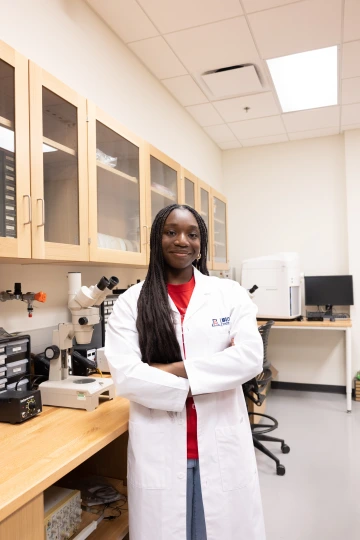
High School: BASIS Peoria
City: Glendale
Faculty Mentor: Dr. Fabian Fernandez
Research Project: The Mind after Mindnight
Suicides occur disproportionately at nighttime between 11pm and 4:59am [3]. My lab is analyzing the neuropsychological mechanisms that cause a higher risk for suicidal thinking. We hypothesize that as a result of increased sleep pressure and disrupted circadian rhythms, nocturnal wakefulness increases the risk for suicidal ideation by causing cognitive-affective dysregulation. I coded surveys on REDCap that have been developed by psychologists to be administered during lab visits to compare participants’ mood and suicidality during the day and during the night after prolonged sleep deprivation. If there is a connection between nocturnal wakefulness and increased suicide risk, then it would be important to target suicide prevention efforts and resources toward people during the nighttime.
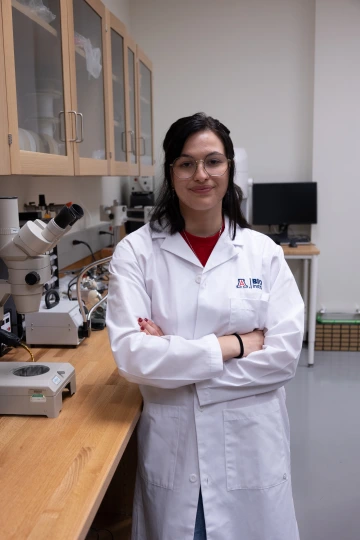
High School: ASU Prep Digital
City: Tucson
Faculty Mentor: Dr. John Schaibley
Research Project: Creating Nano-Structures in 2D Material via Focused Ion Beam Milling
Dr. Schaibley’s lab focuses on 2D crystalline materials—atomically thin materials that restrict electron movement8. They stack these materials to create structures called devices2,9. My goal was to make a nano-structure of 100 nm holes in the 2D material, graphene. The nano-fabrication technique Focused Ion Beam (FIB) Milling, patterned graphene via helium ions1. For future research, patterned graphene will be placed on a 2D capacitor device, manipulating the electrostatic environment to trap electrons in specific regions 2,9,10. Trapping electrons at the nanoscale is crucial for advancing nanotechnology applications, including development of 2D photonic crystals, quantum dots, and single-photon emitters—systems where precise control of electron behavior is essential11,13. It also contributes to fundamental physics research by enabling exploration of particle phenomena.8,12
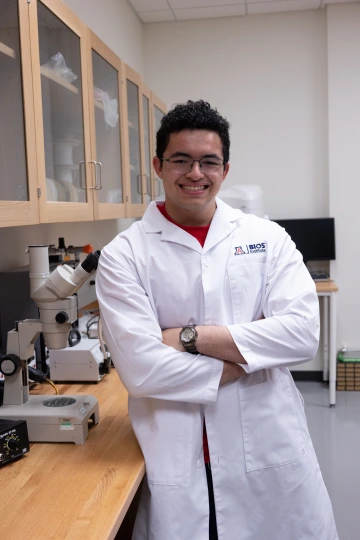
High School: Hamilton High School
City: Chandler
Faculty Mentor: Dr. Brian LeRoy
Research Project: Fabrication of van der Waals Heterostructures Using Monolayer Graphene and hBN
With the rising demand for nanoscale technology, the need for clean, reproducible fabrication of its fundamental building block, devices, grows [11]. With such high demand, the search for a replicable method to fabricate high-quality devices led to our goal: incorporating a 4-step process to fabricate and analyze device quality—as reproduced by previous research. To accomplish this, we first exfoliated atomically thin graphene and hexagonal-boron-nitride, searched for clean pieces, scanned the pieces to ensure their homogeneity, and stacked the pieces on each other. We successfully created a device, demonstrating the feasibility of the 4-step method in fabricating high-quality devices. This method streamlines fabrication and ensures that experimental results derived from these devices can be reproduced across institutions, accelerating fundamental research in next-generation electronics.
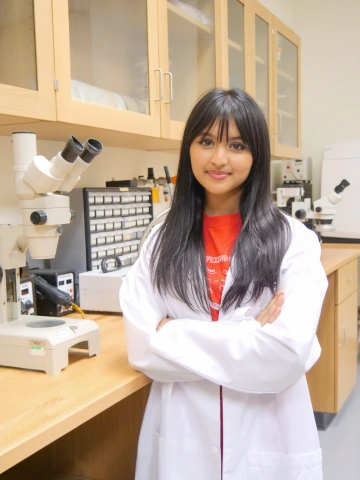
High School: Arizona College Preparatory High School
City: Chandler
Faculty Mentor: Dr. Jeffrey Pyun
Research Project: Fossil Fuel Waste to Sustainable Plastic: Sulfur Purity's Role in the Optical Quality of Inverse Vulcanized Polymers
Petroleum refining produces 70 million tons of elemental sulfur yearly: a byproduct with few industrial applications [2]. However, sulfur’s high transparency in the infrared region makes sulfur-based inverse vulcanized polymers a sustainable alternative to expensive optics. While the general effectiveness of sulfur-polymer-based optics is known, the influence of sulfur purity on their optical quality is understudied. This project investigates how sulfur purification methods used for inverse vulcanized polymer synthesis affects transparency, particularly regarding light scattering from impurities and optical absorption due to discoloration. Using UV-Vis and Fourier-Transform Infrared spectroscopy, our study found that higher sulfur purity improves overall transmittance and minimizes scattering. The results support the refinement of sulfur purification methods to enhance polymer performance, expanding its potential as a sustainable material for advanced optics.

High School: Sonoran Science Academy
City: Tucson
Faculty Mentor: Dr. Martha (Molly) Hunter
Research Project: What's That Smell? Assessing the Role of Olfaction in Bacterial Symbiont Transmission
The leaf-footed bug (Leptoglossus zonatus) needs symbiotic bacteria (Caballeronia) to develop properly. However, it does not get the bacteria from its parents, so where or how does the leaf-footed bug acquire it?3 We investigated if the bugs find their bacteria using smell. We used a Y-tube olfactometer, which presents two different odors, and the leaf-footed bug moves toward one. We presented three odors: adult frass (feces), bug colony soil, and non-contaminated soil vs. an empty control. Data shows that more bugs chose the empty controls over the experimental odors. This suggests that the bugs were avoiding the frass, so we reject our hypothesis. This may mean there is something in the frass that is harmful, or the bugs find the bacteria without smell.

High School: BASIS Peoria
City: Peoria
Faculty Mentor: Dr. Bonnie LaFleur
Research Project: Vitamin D Supplementation and Slowing Biological Aging: Insights from Epigenetic Clocks in the Precision Aging Network
Low vitamin D has been linked to faster cellular aging, but it’s unclear if supplements can reverse this trend. Biological age reflects how old your cells appear—estimated using epigenetic clocks based on chemical tags on DNA. To explore vitamin D’s effect, we
analyzed data from the Precision Aging Network (PAN), comparing users to non-users. Using multivariable linear regression, we found statistical differences in epigenetic age associated with sex, BMI, and education, but not vitamin D. Epigenetic clocks showed consistent patterns across these factors. Our findings do not align with other studies linking vitamin D to epigenetic aging; however, those studies look at changes over time, not as a single snapshot. More studies are needed to clarify whether vitamin D supplementation truly affects biological aging.
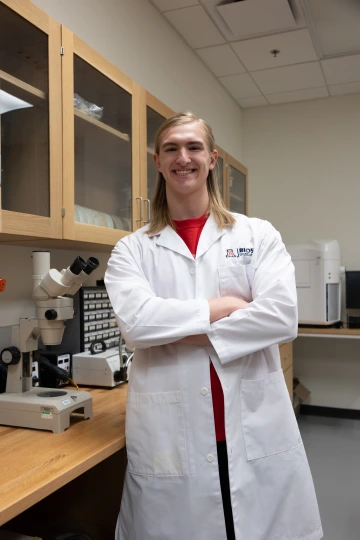
High School: Ironwood Ridge High School
City: Tucson
Faculty Mentor: Dr. Jeong-Yeol Yoon
Research Project: Smartphone-Based Portable Detection of HPV 16 Using Paper-Microfluidic Chips
In my lab we are figuring out the best way to detect HPV 16(Human papillomavirus 16), with a smartphone, as it’s the leading cause of oropharyngeal cancer.[1] We had experimented with various ratios of SYBR Green(a fluorescent dye) and HPV DNA. We amplified DNA so it could be detected and ran it through our testing apparatuses: gel electrophoresis and microfluidic paper chips. The polarity of the paper would pull the DNA through the chip and the flow rate would also change. We found that the highest flow rates are seen with a HPV16 concentration of 0.001μL/μg, 1-3 μL of SYBR Green, and the 437 base pair section of DNA.
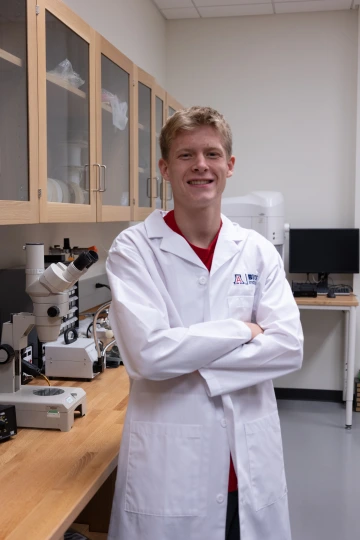
High School: Tanque Verde High School
City: Tucson
Faculty Mentor: Dr. Arvinder Sandhu
Research Project: Automated Beam Stabilization and Characterization of an Ultrafast Laser
The movement of electrons are central to chemical reactions, and control over chemical reactions can lead to advancements in pharmaceutical drug/material design[1]. Electron dynamics is on the attosecond timescale (10-18 s), so ultrashort laser pulses are required to measure dynamics at this timescale[2, 3]. Small changes in atmospheric temperature and pressure causes lasers to
drift, which disrupts experimentation[4]. Using LabVIEW, I made a camera-laser-mirror system that creates a position feedback loop to correct for laser drift. I programmed the camera to automatically adjust the exposure, then find and track the maximum intensity. If the maximum intensity is too far from the target position, the mirror adjusts the laser until it’s centered.
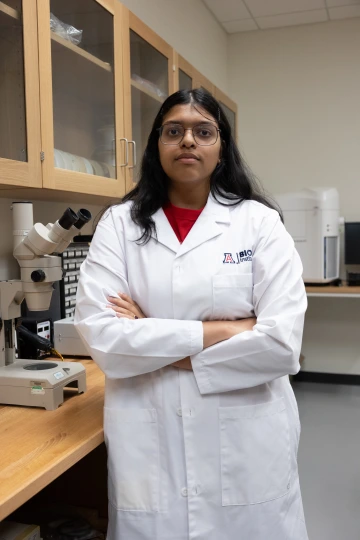
High School: Hamilton High School
City: Chandler
Faculty Mentor: Dr. Erika Eggers
Research Project: Do Calcium Channels Change in Six Week Diabetic Retinas?
35% of people with diabetes develop Diabetic Retinopathy (DR) (vision loss)[2]. This project analyzes two different retinal layers from diabetic and control retinas to investigate if 6 weeks of diabetes alters the expression or relative distribution of bNOS (nitric-oxide producing amacrine cell-a specific type of neuron), CaV1.3 (L-type calcium channels), and/or GAD (GABAergic amacrine cells) in the retina. All retinas were immunostained for the interested proteins, imaged with a confocal microscope and measured with imageJ. No significant differences were found between diabetic and control images. The lab will analyze more retina slices to confirm findings and will perform more immunostainings for other calcium channels to look for changes in early DR.
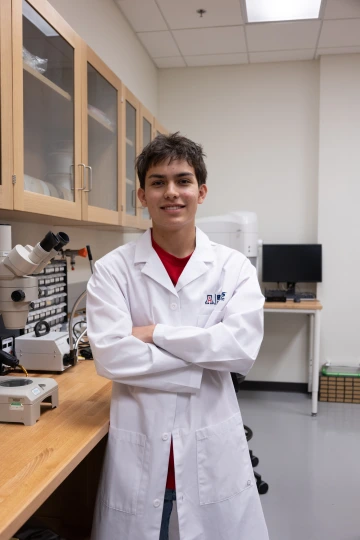
High School: Tucson Magnet High School
City: Tucson
Faculty Mentor: Jennifer Barton
Research Project: Analysis of Ex-Vivo Images of Human Fallopian Tube Taken with Cell-Acquiring Fallopian Endoscope
Ovarian cancer is the most lethal gynecologic cancer and currently has no accepted early screening method [1,2]. The Cell Acquiring Fallopian Endoscope (CAFE) is a minimally invasive device for detecting early signs of ovarian cancer in the fallopian tubes (FTs) [3]. We analyzed fluorescence and reflectance images from ex-vivo human tissue with the goal of finding distinct signal differences between benign and cancerous tissue. We process the images by isolating the region of interest, grayscaling the colored images, and finding the average signal intensity value of each image. With the acquisition and analysis of these images, we have completed the first step to finding significant differences between the ratios of benign tissue and the ratios of cancerous or precancerous tissue.

High School: Pinnacle High School
City: Phoenix
Faculty Mentor: Dr. Melissa Warden
Research Project: Role in Lateral Habenula Circuits for the Regulation of Goal-Directed Behavior in Response to Threats
The lateral habenula (LHb) is a brain region involved in regulating motivation and behavior8. Its activity is associated with reward-seeking behavior, acting as a break on such behaviors4. My project explores how LHb circuits respond to threats in mice, leading to a shift from exploratory to defensive behavior. We used the looming test, which mimics an aerial predator, and the open field test to measure baseline behavior. When presented with the stimulus, mice increased their speed and sought shelter, indicating a defensive response. We are now quantifying cFOS expression, a neural activity marker, and expect elevated LHb activation. These results suggest the LHb plays a key role in mediating behavioral shifts under threat and could be a future target for treating seeking-related behaviors.
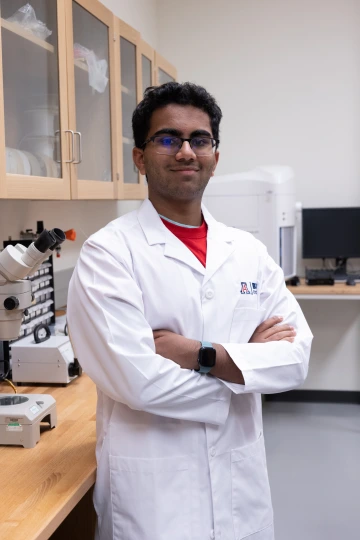
High School: Paradise Valley High School
City: Phoenix
Faculty Mentor: Dr. Teodora Georgieva
Research Project: Assessing the Effectiveness of Different Methods for Delivering CRISPR/Cas9 with AAV Donor DNA to Introduce a Point Mutation in a Gene of a Cancer Cell Line
CRISPR-Cas9 is a gene editing system that uses the enzyme Cas9 to create targeted DNA breaks. Cells repair the DNA using donor templates. If these contain a mutation, it is copied into the genome. We aim to find the most effective way to induce mutations using donor DNA delivered through Adeno-Associated Virus (AAV). Cas9 is delivered by lipofection (positively charged lipids) and AAVs by electroporation (electricity-induced membrane holes). We tested these methods in mouse breast cancer cells by tagging AAVs, sorting for viral presence, and genotyping after DNA amplification. Lipofection resulted in greater AAV entry, but electroporated cells had higher survival. We expect lipofection to induce the mutation most frequently. This insight may improve gene editing methods and inform genetic disease treatments.
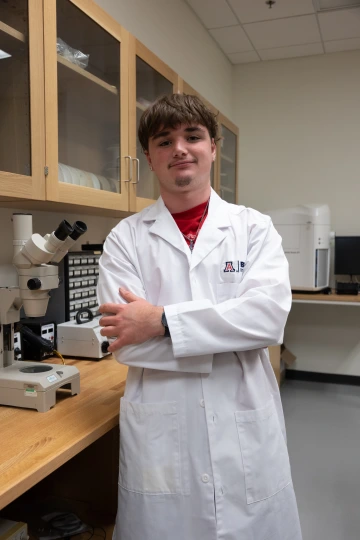
High School: Sahuaro High School
City: Tucson
Faculty Mentor: Dr. Haijiang Cai
Research Project: The Anxiety Paradox: MAGEL2's Role in Prader-Willi Syndrome
Emotional dysregulation is a notable feature in Prader-Willi syndrome (PWS). Individuals with PWS experience high levels of anxiety, particularly around food and daily routines [1]. Loss of function of MAGEL2, a gene on chromosome 15, contributes to emotional dysregulation in PWS[2]. In this project, I investigated whether Magel2-null mice exhibit altered anxiety behavior using
a comprehensive battery of behavioral tests and video tracking software to analyze animal behavior. I found that Magel2-null mice exhibited reduced anxiety in high-risk environments. This finding implies that MAGEL2 mutations may not directly contribute to the high anxiety levels observed in PWS, suggesting a more complex underlying mechanism.
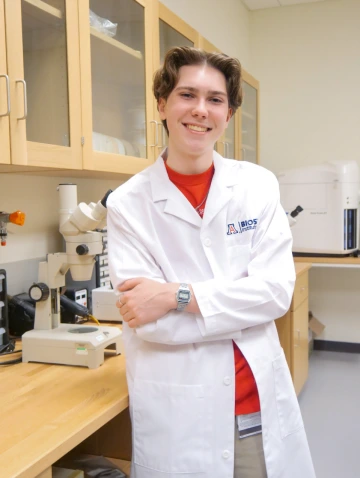
High School: Ironwood Ridge High School
City: Tucson
Faculty Mentor: Dr. Klearchos Papas and Co-PI Dr. Amy Kelly
Research Project: Maintenance of Beta Cell Composition in Isolated Islets Following Transplantation in Encapsulation Pouches
Type One Diabetes (T1D) is a chronic autoimmune disease caused by the destruction of β-cells (insulin-producing cells in islets – cell clusters that regulate blood glucose) from the pancreas.[1] Donor islet transplantation is promising, but requires immunosuppression. Cell pouches that don’t require immunosuppression make this treatment widely applicable. Through staining, imaging, and quantification, I compared β-cell composition of transplanted islets within pouches explanted from animals after 1-14wks to isolated islets in culture. Results showed that after 14wks, islets maintained similar β-cell composition to early and isolated islets. This establishes that insulin-producing cells survive prolonged encapsulation in animals; This opens the door for immunosuppression-free large scale application of cell-based treatment of T1D, especially when an unlimited source of human stem-cell derived islets is utilized.[2]
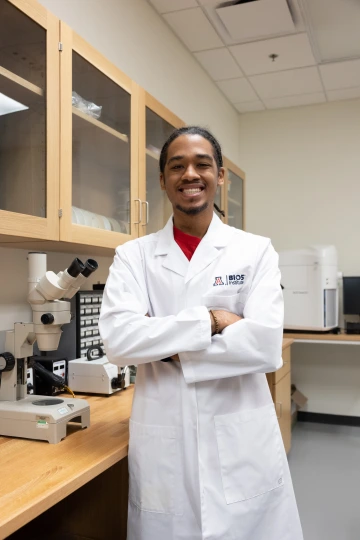
High School: Cienega High School
City: Tucson
Faculty Mentor: Dr. Marielle Hegetschweiler/Walti
Research Project: Probing Molecular Interactions Between Per- and Polyfluoroalkyl substances and Malate Dehydrogenase
Per- and Polyfluoroalkyl substances (PFAS), or “forever chemicals”, are industrial, toxic and resilient chemicals in our environment[9]. Despite their abundance, they are not fully understood; including their potential to cause cancer[9]. We aim to discover if and how PFASbind[16] and affect function of mitochondrial proteins, specifically Malate Dehydrogenase (MDH) and Heat Shock Proteins (HSP). We do this by growing MDH via E coli, filtering the protein out, introducing PFAS like Trifluoroacetic acid (TFA) and perfluorooctanoic acid (PFOA), and observing binding via Nuclear Magnetic Resonance (NMR). NMR proves PFAS are binding to MDH, possibly altering its function. Important future steps include cryo-electron microscopy (Cryo-EM) and functional assays for quantifying and visualizing binding.
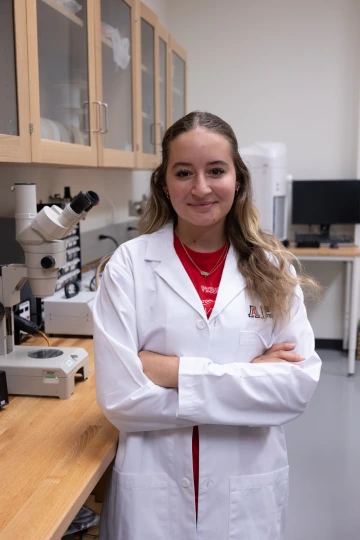
High School: Catalina Foothills High School
City: Tucson
Faculty Mentor: Dr. Maggie O'Haire
Research Project: Benchmarking the Industry: Building Data-Driven Understanding of Service Dog Partnerships
While benefits of service dogs have been proven, the industry is largely understudied and no universal standards for service dog training exist. While metrics are often cited, there is no reliable source for these numbers. This study was to establish accurate data on metrics in the industry. We investigated whether there was an association between dog cost and accreditation status or the service dog’s roles. A list of organizations were compiled in Excel. Data were extracted by examining websites, Google searches, and direct correspondence. It was found that there is no association between dog cost and role. Additionally, there is a wide variety of metric values across the organizations. There must be alternate factors going into service dog cost and there is truly no standard.
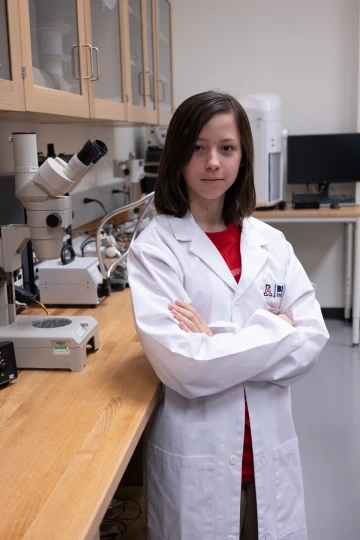
High School: University High School
City: Tucson
Faculty Mentor: Dr. Tai Kong
Research Project: Search for Rare-Earth Metal-Free Magnetic Materials
Rare earth elements are vital for high-performance magnets used in green technologies like electric vehicles and wind turbines [3]. However, they are expensive, energy-intensive to mine, and environmentally harmful [1, 2] We aim to find new, transition metal based magnetic materials that are free of rare earth metals. By varying elemental ratios, we hope to induce electron interactions that favor preferred magnetic alignment. I synthesized two candidate materials—Strontium-Niobium-Titanium-Oxide and Hafnium-Iron-Silicon—by using furnace heating or arc melting. An X-ray diffraction (XRD) was used to confirm phase formation, and a vibrating sample magnetometer (VSM) was used to measure samples’ magnetization. Changes of magnetic properties with respect to samples’ composition will be discussed in the poster.

High School: BASIS Scottsdale
City: Scottsdale
Faculty Mentor: Dr. Nirav Merchant
Research Project: Converse with Your Data: Reproducible LLM-Integrated Dashboards
Large Language Models(LLMs)1 and Data Analysis are two incredibly intertwined topics. Large datasets are fed to LLMs to refine them. But, looking at the inverse: how can LLMs be used to refine and analyze datasets? My full-stack web application “Converse With Your Data” is reproducible pipeline that generates visualizations based on a dataset and uses CyVerse’s Verde2 LLM to translate human language to structured Query Language(SQL)3, a programming language primed for dataset interaction. I used Docker4 (platform allowing programmers to condense software into reproducible containers) and GitHub5 (platform that allows users to publicly share code) to make my application reproducible. This application allows LLM to integrate, making the software extremely flexible in the types of data it can analyze.
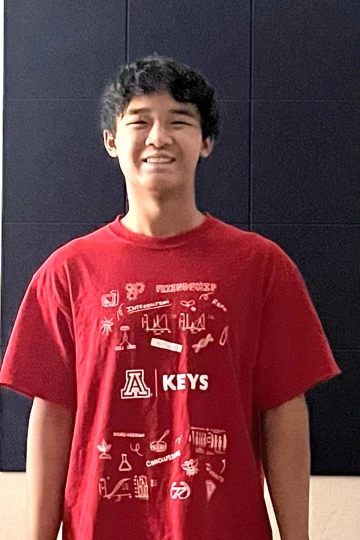
High School: Lincoln Preparatory Academy
City: Chandler
Faculty Mentor: Dr. Guang Yao
Research Project: Predicting Ovarian Cancer Risk from miRNA Data Using Machine Learning
Ovarian cancer (OC) has one of the highest fatality rates of cancers that can be developed by women. OC primarily forms due to a mutation in the BRCA gene, a mutation that also leads to breast cancer. Multiple micro-RNAs (miRNAs) regulate the expression of the BRCA gene. My project was to create a support vector machine, a machine learning tool that classifies between two categories, that could identify whether a patient was at low or high risk for developing OC based on the miRNA counts in their blood. After training the SVM on miRNA numbers from patients at various OC risk levels, the SVM achieved a 92% accuracy at determining whether patients were low or high risk for OC.
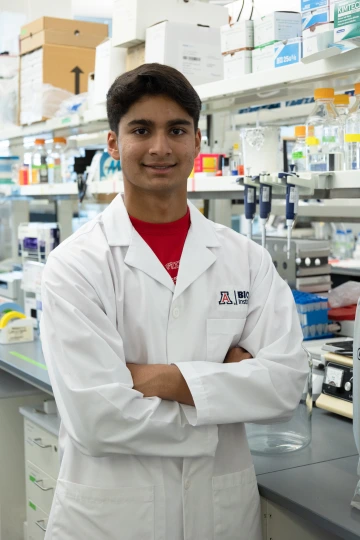
High School: Chaparral High School
City: Scottsdale
Faculty Mentor: Dr. Taben Hale
Research Project: Cardiac Inflammation Under the Influence of Angiotensin II: A Molecular and Cellular Analysis
Angiotensin II is known for regulating blood pressure, but research suggests it also promotes harmful inflammation. Over time, inflammation can damage heart tissue and contribute to heart disease. We hypothesize that Angiotensin II treatment will increase levels of inflammatory markers in rat cells and heart tissue. Rat2 fibroblasts were cultured and treated with different concentrations of Angiotensin II. ELISA was performed on media to detect IL6 and Western blot was used to detect NOX2 in cell lysates. Rats received Angiotensin II infusion for 14 days, and macrophage infiltration was visualized via ED-1 immunohistochemistry on cardiac tissue. Angiotensin II treatment increased IL-6 and NOX2 expression in cells, while also increasing ED-1 expression in heart tissue. This research reveals that Angiotensin II increases inflammation in the heart.
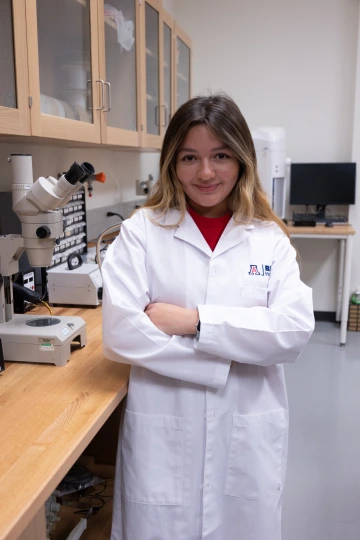
High School: Tucson Magnet High School
City: Tucson
Faculty Mentor: Dr. Alicja Babst-Kostecka
Research Project: Geographical difference of metal compisition in genera Noccaea and Thlaspi
The U.S plays a small role in the extraction of metals globally. Detecting which plants accumulate certain elements can lead to the discussion of utilizing these plants for processing metals (metal farming domestically)1. My project studied the plant families Noccaea and Thlaspi, and tested whether different geographical locations would accumulate the same metals from the same species. We tested this hypothesis using a pXRF scanner that detects metal compositions of plants, later taking our data from the scanner and developing box plots to visualize the metallic differences of the species. We expect the metallic measurements to differ as possible contributing factors could be contrasting environmental traits of diverse locations. We can utilize these plants for the U.S to extract metals domestically.
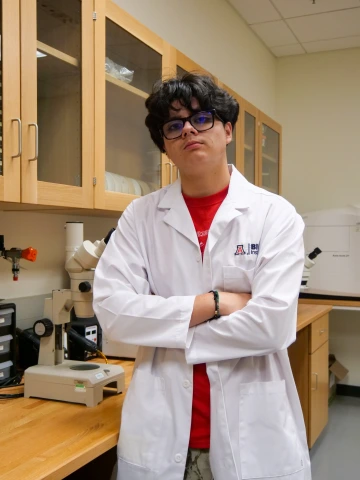
High School: Pueblo Magnet High School
City: Tucson
Faculty Mentor: Dr. Jared Churko
Research Project: Using Cardiomyocytes Derived from hPSCs to Treat Arrhythmias
Heart arrhythmias affect a large part of the world’s population. These are dangerous disorders that could lead to sudden strokes or death due to inadequate blood flow [6]. Arrhythmias like atrial fibrillation affect 10% of 80-year-olds [1]. Using small molecule drug testing on heart muscle cells, we can create new forms of heart therapy and treatments [5;6]. We grow and program stem cells of patients into heart muscles, allowing for more tailored drug testing. Then we monitor drug reactions on the cell's contractions [3;4;9]. This is then compared to baselines to determine effects of drugs, where we see the effects the drugs have on the cells molecularly. All this data gathered is put to help aid in preventative treatments for heart arrhythmias.
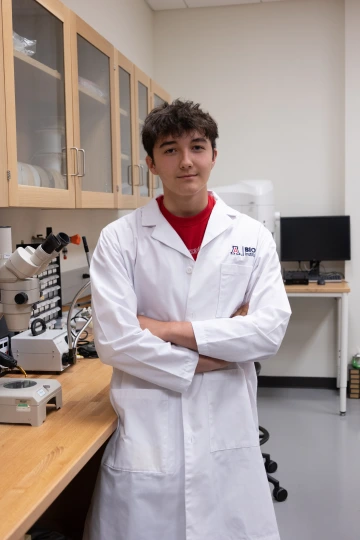
High School: BASIS Scottsdale
City: Scottsdale
Faculty Mentor: Dr. Tally Largent-Milnes
Research Project: Optimizing Astrocyte Isolation from the PAG
Headache and migraine are common, debilitating disorders involving dysfunction in the endocannabinoid (EC) system, a key pain-modulation pathway thought important in headache development.1 A midbrain region within this system critical to headache initiation and persistence is the periaqueductal gray (PAG).4 Astrocytes—cells that regulate neuronal activity—contribute to headache pain.3 Through behavioral testing, we discovered that CB2R, an EC receptor, contributes significantly to pain management in female mice. Previously, my lab developed a protocol to isolate and culture astrocytes from the spinal cord.5 I adapted this method for the PAG, finding that one PAG yields sufficient astrocytes for in vitro study, then isolating typical and CB2R-lacking astrocytes. This optimized protocol enables efficient study of PAG astrocyte morphology and behavior in varying genotypes.
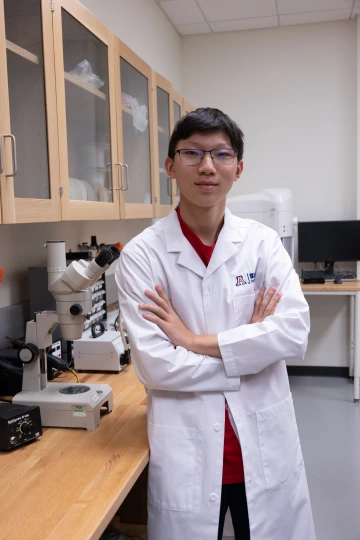
High School: University High School
City: Tucson
Faculty Mentor: Dr. Shravan Aras
Research Project: Using Wearable Sensors to Track Physiological Stress via Heart Rate Variability
Young adult cancer survivors (ages 18–39) often experience chronic stress, impacting recovery and overall well-being. While surveys offer subjective insights, wearable devices can provide continuous, objective measures of physiological stress. This project studies how Heart Rate Variability (HRV) changes before and after mental health interventions. Participants wore Empatica E4 clinical grade wristbands that recorded Inter-Beat Intervals (IBIs), which were segmented and analyzed in five minute windows using Python-based tools. We calculated multiple HRV metrics and observed patterns consistent with reduced physiological stress after the intervention, including more stable heart rhythms and improved nervous system balance. These findings support the use of wearable sensors to track meaningful health changes over time and inform future large-scale studies.
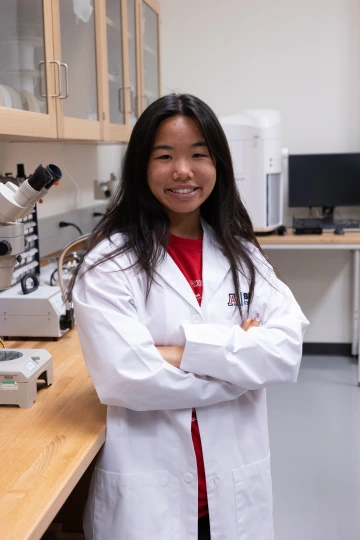
High School: University High School
City: Tucson
Faculty Mentor: Dr. Jacob Shwartz
Research Project: Identifying Drugs That Target DNA Structures to Treat Ewing Sarcoma
Ewing sarcoma is a rare and aggressive bone cancer prevalent in adolescents and young adults[2]. My project focuses on identifying drugs that specifically target Ewing sarcoma cells, asking: which drugs most effectively stop their growth and survival? The research involved culturing two cell lines—cancerous (A673) and non-cancerous (HEK293)—and testing compounds to assess cell damage and death. Ideally, drugs should kill more cancerous cells than non-cancerous cells. Most drugs met this goal, except compound 40. Compound 7 was most effective, killing cancerous cells with minimal impact on healthy cells. These drugs were designed to target a unique DNA structure, the G-quadruplex, thought to be crucial in Ewing sarcoma. Future research is needed to confirm this hypothesis to develop a non-lethal, highly effective drug.



